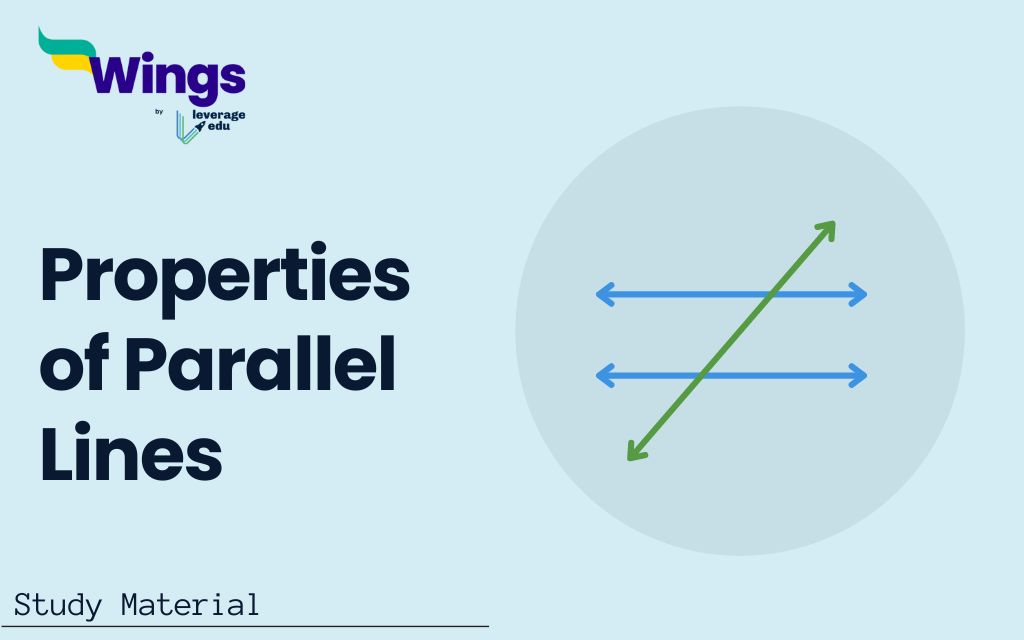There are multiple kinds of lines in geometry, including straight lines, parallel lines, horizontal lines, vertical lines, curved lines, and intersecting lines. Each line has different characteristics and properties that distinguish it from the others. In this section, we will look at the parallel line and its properties in further detail. A good knowledge of properties of parallel lines is important for various competitive exams like JEE, NEET, SSC, Banking, and many state-level exams. To better understand this basic idea of Properties of Parallel Lines, let’s go into more detail.
Contents
What are Parallel lines?
Parallel lines are also referred to as non-intersecting lines. These are the lines that do not intersect at any moment. They are always the same distance apart, thus they never meet. Parallel lines can be seen in railway tracks and cricket stumps.
Parallel lines are a fundamental concept in geometry that is used in a variety of theorems and proofs. The set of parallel lines is denoted by the symbol ||.
Properties of Parallel Lines
The properties of parallel lines are as follows:
- Transitive Property of Parallel Lines
- Symmetric Property of Parallel Lines
- Transversal Property of Parallel Lines
Now, we will look at these properties in more detail.
Also Read: Define Line in Maths: 9 Types and Examples
Transitive Property of Parallel Lines
The Transitive Property of Parallel Lines states that the lines which are parallel to the same line are also parallel to each other. This property can be applied for more than two lines as well. To make this more comprehensive, let us understand it with an example.
In the above diagram,
Line k is parallel to the line l and line l is parallel to line m. This means that line k is also parallel to line m. So, we can say, if k || l and l || m, then k || m
Symmetric Property of Parallel Lines
The Symmetric Property of Parallel Lines states that parallel lines are also symmetrical. When two parallel lines undergo the same series of transformations, they remain parallel.
In the image above,
we can see that if line k is parallel to line l, then line k is also symmetrical to line l.
Also Read: Concept Of Parallel Axis Theorem
Transversal Property of Parallel Lines
In geometry, a transversal is a line that crosses two or more parallel lines. The transitive property of parallel lines states that when a transversal line intersects a pair of parallel lines, different pairs of angles are formed. These different angles are used to determine whether two lines are parallel to one another.
There are different types of angles formed during this intersection. These angles are described below.
Corresponding Angles of Parallel Lines
This states that when a transversal line cuts two lines, then the corresponding angles will be equal. They are angles that are in distance and lie on the same side of the transversal.
In the diagram above,
Line l is parallel to line m, so its corresponding angle a and angle b will be equal.
Alternate Exterior Angles of Parallel Lines
This states that when a transversal intersects two parallel lines, then its alternate exterior angles are equal. Alternate exterior angles are pairs of angles on the outer side of the transversal that are opposite each other.
In the above diagram,
Two lines are intersected by a transversal are parallel, then its alternate exterior angle angle a and angle h are equal
Also Read: Different Types of Angles with Formulas and Examples
Alternate Interior Angles of Parallel Lines
This states that when a transversal intersects two parallel lines, then its alternate interior angles are equal. These are the pair of angles existing on the inner side of the transversal that are opposite each other.
In the above diagram,
Line a is parallel to line b, so its alternate interior angle α and angle β will be equal.
Consecutive Interior Angles
This states that when a transversal intersects two parallel lines, then the sum of the consecutive interior angles is 180°. The angles are formed on the inside of the two lines, on the same side as the transversal.
In the above diagram,
Line r is parallel to line s, so its consecutive interior angle f and angle d will be equal and there sum will be equal to 180°.
FAQs
What are parallel lines?
Parallel lines are also referred to as non-intersecting lines. These are the lines that do not intersect at any moment. They are always the same distance apart, thus they never meet. Parallel lines can be seen in railway tracks and cricket stumps.
The properties of parallel lines are as follows:
–Transitive Property of Parallel Lines
–Symmetric Property of Parallel Lines
–Transversal Property of Parallel Lines
The transitive property of parallel lines states that when a transversal line intersects a pair of parallel lines, different pairs of angles are formed. These different angles are used to determine whether two lines are parallel to one another.
RELATED POSTS
This was all about the “Properties Of Parallel lines”. For more such informative blogs, check out our Maths Section, or you can learn more about us by visiting our Study Material Section page.
 One app for all your study abroad needs
One app for all your study abroad needs














